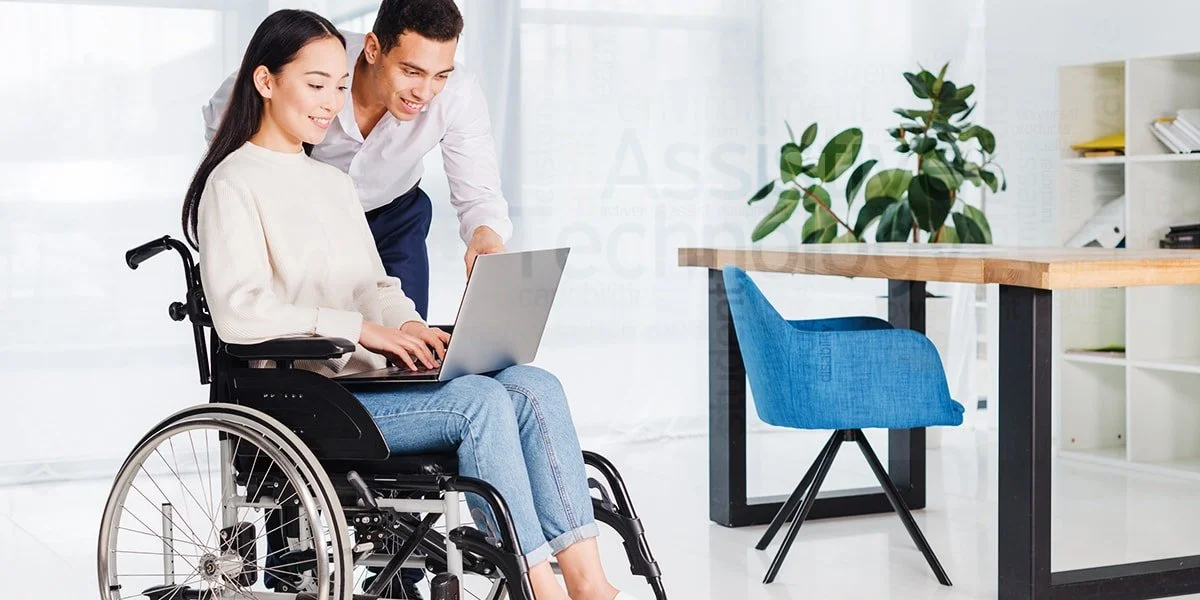
Assistive technology (AT) makes it viable for individuals with various physical disabilities to take part in life exercises at school, home, work, and in the community in general. It increases functional, developmental, and learning abilities. It can replace skills that a person may not be able to form in his/her lifetime. For instance, a person may have challenges with using the voice, but AT can allow the person to communicate what he/she wants, like thoughts and needs. Age or gender is no bar to benefit from AT.
Standard computing technologies such as monitors, keyboards and computer mice can be challenging or impossible to operate for some individuals who are differently-abled physically. This can become a barrier to navigating the digital world. Fortunately, there are alternative methods which can provide support and are known as assistive technologies. Today, slowly but steadily, these technologies are used for browsing the web. While the term “assistive technology” can be applied to any device to make tasks possible or easier (such as wheelchairs and hearing aids), our blog speaks only of those assistive technologies used in replacing computing devices.
ATIA – Following the Rules
The Assistive Technology Industry Association (ATIA) is committed to granting access to its website to people with various physical disabilities. ATIA obeys the W3C’s Web Content Accessibility Guidelines (WCAG) 2.0 AA to provide accessible content. The following general measures are taken to ensure that the sites are accessible include but are not limited to:
- Images have relevant alt text.
- Links make sense when placed in the connection of the page
- Tabular data is marked up accurately
- Structural markup indicates headings, landmarks, and lists, aiding in page perception, navigation and comprehension.
- Form fields are exclusively affiliated with their prompts
- Style sheets are used for delivering
- Pages can be expanded using the zoom functions of the browser.
- All copy passes fundamental colour contrast ratios
Understanding the Basic Difference
Before we delve any further, let’s answer to the most common query our visitors have in mind – what is the difference between assistive technology and accessible technology?
Employers, developers, and people with disabilities should understand the differences between the two and also how they complement each other. Assistive technology is what’s been specially devised to help a person with a limitation to perform a task. For instance, a screen reader on a computer can serve a person with any visual inability to read a job posting.
Accessible technology is what’s been designed, keeping in mind the need for a lot of different users. It’s a technical implementation with built-in customization features that users can use to customize their experience to meet their needs. Assistive technology alone will never guarantee access for people with disabilities. This is because websites and software also need to be redesigned with keeping in mind for people with accessibility can be able to use them. This is precisely why you need Ananyoo to help you build an accessible website.
Why Your Accessibility Solution Should Include Assistive Technology
When customers with disabilities use services, purchase products, or otherwise go about their everyday lives, they have every right to a barrier-free experience. Legislation such as the Americans with Disabilities Act (ADA) protect this right. Consequently, companies and organizations which provide these services products are bound to ensure they’re accessible – or risk infringing the law. However, what’s not always outlined in those laws, are the methods by which a barrier-free experience is delivered. It may be up to the company itself to figure out what best meets its accessibility obligations. It should have a proper evaluation of all its digital properties. This will include the websites as well as the apps to ensure they’re usable by people with disabilities.
It may also cover building a way to tell individuals with disabilities about the range of accessible services available and how to use them — for instance, publishing an accessibility statement or engaging consumers on a dedicated web page that highlights disability-specific services. We think your organization should also be providing software to make it easier for people with disabilities to access your website.
An AT suite of tools or an app can help persons who have difficulty typing on a keyboard, moving a mouse, reading the words on a screen, or working on a touch screen. It can enable them to drive a website and conduct transactions effortlessly.
Don’t people already have their assistive technology?
In a word, the answer is no. Researches demonstrate that a notable number of people with physical limitations don’t have the assistive technologies they need. Often it’s because they feel they can’t afford it. This is especially when increased costs start to add up, for instance, $600 for ZoomText software or $900 for the JAWS screen reader.
Even if it’s not all about the expenses, many people are not aware of what’s available. According to the World Health Organization, one of the top reasons why not all individuals with disabilities have assistive technology is a lack of awareness. People may not recognize what AT can do for them or what technical innovations have come out since the last time they looked into it.
By now, you must have a got a fair idea that assistive technology is a generic term which describes tools used by people with disabilities to accomplish various tasks.
- Screen magnification software: This software allows users to check the size of text as well as the graphics on the screen. Unlike the zoom feature, these applications allow users to see an enlarged version to the rest of the screen. This is done by copying a handheld magnifier over the screen.
- Screen readers: It is the most common software used by blind or visually impaired people to read the content of the computer screen. Famous examples include NVDA, JAWS for Windows and Voiceover for Mac.
- Text readers: Another popularly used software used by those suffering from learning disabilities, which affects their ability to read the text. This software will read the content with a synthesized voice and may have a highlighter to indicate the word being spoken. These applications do not understand something, such as types of elements or menus but can only read the text.
- Speech input software: It provides people with trouble typing a substitute way to type text and control the computer. Users can use limited commands to perform mouse actions. Users can also tell the system to click a button or a link or use a menu item. Notably, both Windows and Mac have some speech recognition utilities, but they cannot be used to browse the web.
- Alternative input devices: Some users might have challenges in using a mouse or keyboard. The various forms of devices, such as:
- Head pointers: A stick or object which is mounted directly on the user’s head can be used to push keys on the keyboard. This device is used by those who cannot use their hands.
- Motion tracking or eye tracking: As the name suggests, it can watch a target or even the eyes of the user to decipher where the person wants to set the mouse pointer and moves it accordingly
An Innovative Solution
Ananyoo has developed a complete comprehensive accessibility solution to help companies and businesses follow the Web Content Accessibility Guidelines (WCAG). It will help them achieve and maintain compliance with standards and regulations accepted globally. This includes integrating web compliance evaluation services along with assistive technology to deliver a transformative experience for anyone who is challenged with disabilities. Learn more about Ananyoo today!
